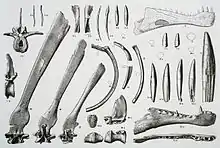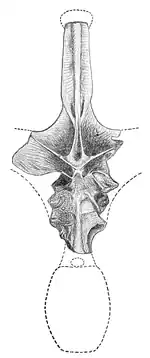List of lost, damaged, or destroyed dinosaur specimens
This list of lost, damaged, or destroyed dinosaur specimens enumerates those fossil dinosaur specimens that have been discovered only to be lost or damaged after initial documentation. Some of these specimens which had gone missing were later recovered as well.
Uncollected specimens
| Nickname | Taxon | Age | Unit | Country | Notes | Images |
|---|---|---|---|---|---|---|
|
Nose Mountain theropod track |
Single highly pathological tyrannosaur footprint that was buried under a landslide before it could be collected. |
|||||
Destroyed specimens
| Nickname | Catalogue Number | Institution | Taxon | Age | Unit | Country | Notes | Images |
|---|---|---|---|---|---|---|---|---|
|
Upper Cretaceous |
Bahariya Formation |
Destroyed in Germany during World War II when the bombing of the museum it was held in took place. |
||||||
|
IPHG 1922 X 47, X 48 |
Upper Cretaceous |
Bahariya Formation |
Destroyed in World War II. |
|||||
|
IPHG 1922 X46 |
Upper Cretaceous |
Destroyed in World War II. Used by Ernst Stromer to erect Carcharodontosaurus for "Megalosaurus" saharicus.[3] |
||||||
|
Lower Cretaceous |
Destroyed in World War II. |
|||||||
|
Upper Jurassic |
Most specimens, although not all, were destroyed when the German museum that they were in was bombed in World War II. |
|||||||
|
Lower Jurassic |
The original specimen was destroyed in a museum fire. |
 Type specimen | ||||||
|
Middle Jurassic |
Destroyed in World War II. |
|||||||
|
BSP 1912 VIII 19 |
Lower and Upper Cretaceous |
Bahariya Formation |
Destroyed in Germany during World War II when the bombing of the museum it was held in took place. More material has been discovered since. |
 Illustration of the destroyed specimen |
Lost specimens
| Nickname | Catalogue Number | Institution | Taxon | Age | Unit | Country | Notes | Images |
|---|---|---|---|---|---|---|---|---|
|
Specimen 9[4] |
None |
Canada |
_(20135543774).jpg.webp) Excavation of one of the lost Corythosaurus specimens | |||||
|
Specimen 13[4] |
None |
Canada |
||||||
|
Cardiodon type specimen |
Middle Jurassic |
Forest Marble Formation |
United Kingdom |
 The single tooth Owen founded the genus Cardiodon upon. | ||||
|
Type specimen of Amphicoelias fragillimus |
AMNH 5777[5] |
United States |
Named as the holotype of Amphicoelias fragillimus by Edward Drinker Cope and then subsequently lost. It is possible that Cope himself or someone else disposed of it, or that it crumbled because of inadequate preservation methods.[5] |
 Only illustration of the vertebra | ||||
|
Companion tracks of MGUH 27219 |
N/A |
Geological Museum of Copenhagen |
Thyreophora |
Rhaetian |
Hoganas Formation |
Sweden |
||
Recovered specimens
| Nickname | Catalogue Number | Institution | Taxon | Age | Unit | Country | Notes | Images |
|---|---|---|---|---|---|---|---|---|
|
Holotype of Aepisaurus elephantinus |
Middle Cretaceous (Albian) |
Named as holotype of Aepisaurus elephantinus. Rediscovered in 2006.[6] |
||||||
Footnotes
- Holtz, Thomas R. Jr. (2008) Dinosaurs: The Most Complete, Up-to-Date Encyclopedia for Dinosaur Lovers of All Ages Supplementary Information
- Rauhut, (1995). "Zur systematischen Stellung der afrikanischen Theropoden Carcharodontosaurus Stromer 1931 und Bahariasaurus Stromer 1934." Berliner geowissenschaftliche Abhandlungen, E16 (Gundolf-Ernst-Festschrift): 357-375.
- Stromer, 1931. Ergebnisse der Forschungsreisen Prof. E. Stromers in den Wüsten Ägyptens. II. Wirbeltier-Reste der Baharîjestufe (unterstes Cenoman). 10. Ein Skelett-Rest von Carcharodontosaurus nov. gen. Abhandlungen der Bayerischen Akademie der Wissenschaften Mathematisch-naturwissenschaftliche Abteilung, Neue Folge. 9, 1-23
- Spalding (2001); "The Lost Specimens," page 499.
- Carpenter, K. (2006); in passim.
- Tortosa T, Buffetaut E. 2007. Rediscovery and redescription of the holotype of Aepysaurus elephantinus Gervais 1848–1852 (Dino-sauria-Sauropoda). In : J Le Loeuff, ed. 5th Meeting of theEuropean Association of Vertebrate Palaeontologists, 12thEuropean Workshop of Vertebrate Palaeontology, Carcassone-Espéraza, May 15–19, 2007, Abstract volume, 64 (PDF) New historical data on the first dinosaurs found in France. Available from: https://www.researchgate.net/publication/323538475_New_historical_data_on_the_first_dinosaurs_found_in_France [accessed Sep 03 2018].
References
- Carpenter, K. (2006). "Biggest of the big: a critical re-evaluation of the mega-sauropod Amphicoelias fragillimus." In Foster, J.R. and Lucas, S.G., eds., 2006, Paleontology and Geology of the Upper Jurassic Morrison Formation. New Mexico Museum of Natural History and Science Bulletin 36: 131–138.
- Spalding, D. A., 2001, Bones of contention: Charles H. Sternberg's lost world: In: Mesozoic Vertebrate Life, edited by Tanke, D. H., and Carpenter, K., Indiana University Press, pp. 481–503.